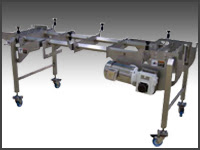In part two of our series on sanitary conveyors we will be talking about what sanitation is and how it relates to the design of the conveyor. Sanitation refers to conditions of the conveyor equipment that are free from particles such as filth or pathogens that could endanger public health. To make sure food remains safe during processing, appropriate sanitation programs along with the construction of the conveyor equipment must adhere to sound sanitary design principles. These principles provide a guideline so sanitary equipment can be designed to be adequately cleaned and sanitized. All surfaces of the conveyor must be able to withstand a corrosive wash down environment due to exposure from chemicals. Equipment that does not adhere to these sanitary design principles cannot be adequately cleaned and sanitized.
The main purpose for cleaning and sanitizing conveyor equipment is the complete removal of food and its byproducts from the food contact and non-food contact zones. The cleaned equipment must be able to fully drain and air dry to prevent bacteria growth. The preferred order for cleaning food contact surfaces are the following:
- Rinse
- Clean
- Rinse
- Sanitize
Equipment that’s been sanitized refers to the reduction of microorganisms levels considered to be safe for human consumption. In the rinse, clean, rinse, sanitize cycle, water accounts for nearly 95%-99% of the solution used to clean and sanitize. First, water removes food and contamination from the equipment surfaces. Next water is mixed with a detergent to clean the surface of the equipment. This solution is then rinsed from the equipment with water to allow for the final step of sanitization. Sanitization can be generalized into two categories, thermal and chemical. Thermal sanitization involves the use of hot water or steam on equipment surfaces for a specific period of time to kill microorganisms. Chemical sanitization involves the use of chemicals to clean surfaces at a specific period of time.

Sanitary equipment must be able to with stand not only food and its corrosive properties but also the chemicals that are used to clean the equipment. The American Meat Institute’s (AMI) 10 Principles of Sanitary Design provides advanced sanitary design guidelines under a general standard. These principles can be easily adapted to other food related industries as well.
Conveyor equipment that abides by the AMI’s 10 Principles of Sanitary Design must follow a rigid format in designing the conveyor. The construction and materials of the conveyor must have all food contact surfaces smooth, free of cracks and crevices, nonporous, nonabsorbent, non-contaminating, nonreactive, corrosion resistant, cleanable, with all connecting surfaces flush and continuous.
An array of diverse materials are present in the construction of sanitary conveyors. Each conveyor can have different levels of sanitation requirements for food handling purposes. Therefore, sanitary conveyors can be tailored to an individual food product line while still retaining characteristics of a similar conveyor design. Depending on the application needed, a variety of metals and non metals are used in the construction of the conveyors.
Stainless steel is the preferred metal of choice when constructing sanitary conveyor. Stainless steel has the benefits of cost effectiveness, durability and has a high resistance to corrosion. Not all Stainless steel is created equally though. Stainless steel is rated on its alloy properties and how it relates to the composition of chromium and nickel levels. Corrosion resistance differs with the amount of chromium used in the stainless steel. While structural strength of the stainless steel is affected by the amount of nickel present.
Other acceptable metals that can be used for sanitary conveyor equipment are:
- Titanium
- Platinum
- Gold
- Copper
- Aluminum
Depending on the level of sanitation required conveyor equipment can be designed as either clean-in-place (CIP) or clean-out-of-place (COP). With a CIP type conveyor system all of its components must be designed to be cleaned without any disassembly, while not allowing any pathogens to integrate back into the food supply chain. The advantage of CIP systems is it allows for faster cleaning and less chemical usage. Clean-out-of-place conveyor systems allow for disassembly of key component parts to be removed from the conveyor and taken to a separate wash down area. The key advantage of COP systems are food product can be easily detected and therefore easily removed.
In food processing facilities there can be many different unique sanitary conveyor requirements dependent on the food being processed to the conditions of the facility. A well designed conveyor that follows the guidelines put forth by government agencies will help reduce the outbreak of food borne illnesses. Along with proper sanitation procedures, plant managers can safely and reliably keep consumers safe.
Arrowhead Systems sanitary line of conveyor, NeXtconveyor, offers three distinct tiers of sanitation classifications dependent on processing need. By establishing these classifications customers can easily determine what type of conveying system they will need and know that it will meet government standards.
Our NeXtgen Sanitary Conveyor is a table top conveyor that features an open-frame design, constructed from 304 Stainless Steel, and is our base sanitary modular conveyor. The NeXtgen II is our mat top sanitary conveyor that also features the patented open-frame design and is fully 304 Stainless Steel constructed. The NeXtgen II is a BISSC Verified conveyor and has been designed to be easily cleaned. The NeXtgen Ultra is our ultimate sanitary conveyor featuring a fully-welded, open frame 304 Stainless Steel construction. The NeXtgen Ultra features tool free assembly and disassembly of its components and parts, and is NSF certified while meeting the sanitary requirements of USDA, AMS, BISSC and 3A-Dairy specifications.











